In today’s fast-paced digital era, businesses must adapt to the ever-evolving landscape of digital marketing to stay competitive. Whether you’re a small startup or an established enterprise, understanding the nuances of digital marketing can be the key to sustained growth and success.
Benefits of Digital Marketing
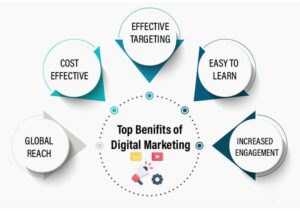
Digital marketing provides a spectrum of benefits that traditional channels simply can’t replicate.
- Precise Audience Targeting: Platforms like Google Ads and Facebook Ads let you segment audiences by age, gender, location, interests, and online behaviors. Retargeting recaptures visitors who didn’t convert initially, boosting conversion rates by up to 70%.
- Higher Return on Investment: Spending 62% less than traditional outbound tactics and yielding over three times the leads, content marketing sets the benchmark for efficiencyEmail marketing returns about $38 for every $1 invested, making it one of the highest-performing channels.
- Real-Time Analytics and Optimization: With real-time dashboards, you can track KPIs—such as website traffic, click-through rates, and conversions—and adjust campaigns instantly. “Such flexibility minimizes wasted budget while boosting campaign effectiveness.”
- 24/7 Brand Visibility: An SEO-optimized website and active social profiles ensure your brand is discoverable around the clock, even when your physical location is closed.
- Enhanced Customer Engagement: Interactive formats—polls, quizzes, live streams—foster two-way dialogue, building trust and loyalty. Personalized email workflows and chatbots maintain engagement, nurturing leads until they’re ready to buy.
- Scalability: This flexibility ensures marketing budgets are invested where they deliver the greatest returns.Digital campaigns can start small and scale up based on performance metrics. This flexibility ensures marketing budgets are invested where they deliver the greatest returns.
- Data-Driven Insights: Advanced analytics and AI-powered tools provide deep insights into customer behavior, preferences, and purchase drivers—enabling hyper-personalized experiences.
Digital Marketing Strategies
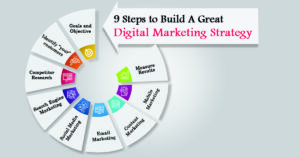
A multi-channel approach is essential. Here are the core strategies for 2025:
Search Engine Optimization (SEO)
In today’s fast-evolving digital landscape, businesses must go beyond basic tactics to capture attention, earn trust, and drive consistent growth. A comprehensive digital marketing strategy combines data-driven decisions with engaging content, personalized communication, and platform-specific tactics. From optimizing for local SEO and leveraging powerful CRM tools to creating compelling videos and tapping into influencer networks, success in digital marketing now depends on an integrated approach. The following key areas outline a complete blueprint that modern brands can use to boost visibility, engage audiences, and convert prospects into loyal customers.
- Keyword Research: Identify high-intent and local keywords (e.g., “best café in Malappuram”).
- On-Page & Technical SEO: Optimize meta tags, headings, site speed, mobile usability, and secure connections.
- Backlink Building: Earn high-quality inbound links to boost domain authority.
- Blog Posts & Guides: Address customer pain points with in-depth, SEO-optimized articles.
- Lead Magnets: Offer eBooks, webinars, and checklists to exchange value for contact information.
- Video Content: Use short-form (Reels, TikToks) for engagement and long-form for tutorials or case studies.
- Social Media Marketing: Platform Selection: Instagram for visual storytelling; LinkedIn for B2B; Facebook for community building.
- Content Calendar: Mix educational, promotional, and user-generated content with interactive formats (polls, Stories).
- Paid Social Ads: Geo-targeted campaigns drive both online conversions and foot traffic.
- Email Marketing: Segmentation & Personalization: Group subscribers by behavior and interests to deliver relevant content.
- Automation Workflows: Set up drip campaigns such as welcome sequences, abandoned-cart reminders, and re-engagement series.
- Pay-Per-Click (PPC) Advertising: Google Ads: Target commercial-intent keywords with compelling copy and ad extensions.
- A/B Testing: Experiment with headlines, CTAs, and landing page layouts to optimize conversion rates.
- Video Marketing: Short-Form Videos: Engage audiences on TikTok, Instagram Reels, and YouTube Shorts.
- Build Authority: Hosting live events positions your business as a thought leader in your industry. Influencer & Affiliate Marketing
- Micro-Influencers: Partner with niche creators whose followers align with your target market.
- Affiliate Programs:Incentivize partners with commissions to advocate for your products.
Digital Marketing Strategies for Small Businesses
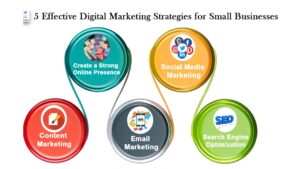
“By zeroing in on specialized offerings and leveraging neighborhood-focused tactics, small businesses can outperform larger competitors.”
- Local SEO: Optimize Google Business Profile, solicit positive reviews, and target geo-keywords (“Malappuram dentist”).
- WhatsApp & SMS Marketing: Send permission-based, high-open-rate messages for direct engagement.
- Community Engagement: Host webinars, workshops, and partner with local events to showcase expertise.
- Cost-Effective Social Ads: Promote local posts and launch click-to-WhatsApp campaigns for just ₹100/day.”
- Case Study: A Malappuram bakery boosted weekend sales by 50% through a ₹300/day Instagram Reel campaign combined with optimized Google My Business updates.
Role of Artificial Intelligence in Digital Marketing
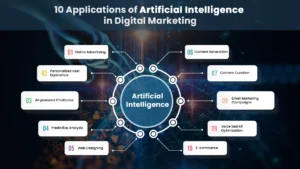
AI is a cornerstone of 2025’s digital strategies:
- Task Automation: AI tools automate scheduling, audience segmentation, and initial copy generation—freeing teams for high-value work.
- Predictive Personalization: Machine learning analyzes behavior to predict needs and deliver tailored content—boosting engagement and conversion rates.
- Chatbots & Virtual Assistants: AI-powered chatbots handle FAQs, qualify leads, and provide 24/7 support—enhancing customer experience and reducing costs.
- AI-Driven Ad Optimization: Platforms like Meta Advantage+ adjust bids and creative elements in real time based on performance data.
Latest Trends in Digital Marketing
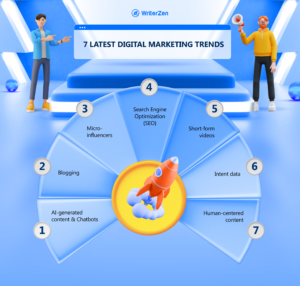
Staying ahead requires embracing these 2025 trends:
- Voice Search Optimization: Optimize for conversational queries (e.g., “nearest organic grocery open now”) as smart speaker usage grows.
- Short-Form Video Dominance: Reels, Shorts, and TikToks capture fleeting attention spans, driving shares and brand recall.
- Social Commerce: Shoppable posts on Instagram and Facebook enable seamless in-app purchases.
- Augmented Reality (AR) Experiences: AR “try-before-you-buy” features enrich product demos, reducing purchase hesitation.
- Sustainability & Ethical Branding: Consumers favor brands with eco-friendly and socially responsible practices—showcase these values.
- Omnichannel Integration: Create unified experiences across digital and physical touchpoints for seamless customer journeys.
How Digital Marketing Helps Grow Your Business
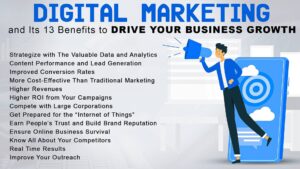
Digital marketing maps directly to each stage of the buyer’s journey:
- Awareness → Traffic: SEO and paid ads attract qualified visitors.
- Traffic → Leads: Content offers and retargeting convert visitors into prospects.
- Leads → Sales: Optimized funnels, personalized follow-ups, and strong CTAs drive purchases.
- Sales → Loyalty : Email nurture, loyalty programs, and social engagement foster repeat business. By aligning tactics with funnel stages, businesses create a scalable growth engine that delivers predictable results over time.
Measuring Success in Digital Marketing
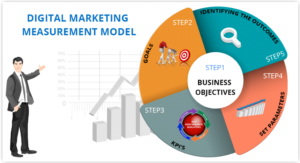
- Advanced Analytics and Attribution Models: Modern analytics tools offer deeper insights into customer journeys and campaign performance. Utilizing advanced attribution models helps in understanding the impact of each marketing touchpoint.
- Customer Lifetime Value (CLV) Focus: Shifting focus from short-term sales to long-term customer value encourages strategies that enhance customer retention and loyalty, ultimately increasing profitability.
Advanced Strategies and Technologies
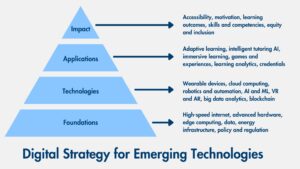
- AI Integration:Utilizing AI for personalized content, predictive analytics, and automating marketing tasks to enhance efficiency.
- Voice and Visual Search Optimization:Adapting content for voice-activated searches and visual discovery tools to meet evolving consumer behaviors.
- Hyper-Personalization:Delivering tailored experiences to users based on their preferences and behaviors to increase engagement.
- Omnichannel Marketing: Providing a seamless and consistent customer experience across multiple channels and touchpoints.
Emerging Trends in Digital Marketing (2025)
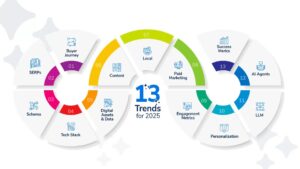
- Shift Towards First-Party Data and Community Building: As privacy laws tighten and third-party cookies are phased out, businesses are turning to first-party data as a top priority. This shift emphasizes building direct relationships with consumers through community initiatives, loyalty programs, and personalized experiences.
- Evolutin of Search Behavior : The rise of AI chatbots and voice assistants is transforming how consumers search for information. Brands are adapting by optimizing content for conversational queries and ensuring visibility within AI-driven platforms.
- Integration of Generative AI in Marketing: Marketers are leveraging generative AI tools to create content, design visuals, and develop personalized campaigns at scale. This technology enhances efficiency and allows for rapid experimentation with different marketing strategies.
- Emphasis on Ethical and Sustainable Marketing: Today’s consumers are more likely to choose brands that uphold ethical values and embrace sustainability. Digital marketing strategies now often highlight a company’s commitment to social responsibility, environmental sustainability, and ethical sourcing.
- Rise of Micro and Nano-Influencers: Brands are collaborating more with micro and nano-influencers who, despite smaller followings, often boast higher engagement rates and more niche audiences. This approach allows for more authentic and targeted marketing efforts.
Measurement and Analytics
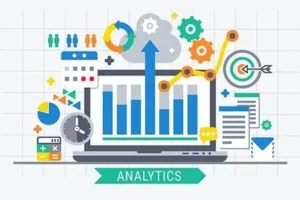
- Enhanced Attribution Models: Implementing advanced analytics to understand the impact of each marketing channel on customer conversions.
- Focus on Customer Lifetime Value (CLV):Prioritizing long-term customer relationships over one-time transactions to maximize profitability.Harnessing real-time data to drive smarter marketing choices and adapt rapidly to market shifts.Utilizing real-time data to make agile marketing decisions and stay ahead of changing market dynamics.
Social Media and Influencer Dynamics
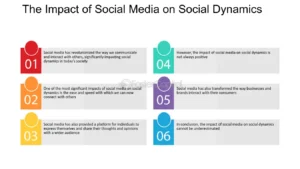
Micro and Nano-Influencer Collaborations: Brands are partnering with influencers who have smaller but highly engaged audiences, resulting in more authentic and effective marketing campaigns.
Content Experimentation: Companies are embracing unpolished, behind-the-scenes content to foster authenticity and stronger connections with audiences.
Search Evolution: Beyond Traditional SEO

- Generative Engine Optimization (GEO): As AI chatbots like ChatGPT and Claude become primary information sources, brands are optimizing content to appear favorably in AI-generated responses, marking a shift from traditional SEO practices.
- Social Search Optimization: With platforms like TikTok and Instagram serving as search engines for younger audiences, businesses are tailoring content to align with social media search behaviors.
Conclusion
The digital marketing landscape in 2025 is characterized by rapid technological advancements and shifting consumer behaviors. By embracing innovative strategies such as Generative Engine Optimization, experiential marketing, and neuromarketing, businesses can create more personalized and engaging experiences for their audiences. Staying abreast of these trends and adapting accordingly is crucial for sustained growth and competitiveness in the digital era
Author Afnansha

